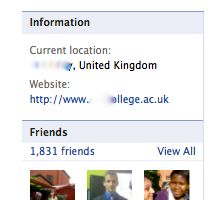Social Media in Education (Part 1)
I was fortunate to participate in the recent Social Media in Education podcamp at Doncaster College. In the midst of many people highlighting the benefits of social media, I speculated about the reasons so many initiatives from educational establishments fail to engage. Not to ridicule or condemn but to improve. This is about learning, after all.
My slightly provocative take on the issue isn’t because I think Facebook, Twitter, et al are frivolous and whimsical distractions. I don’t consider myself a Luddite. My whole career has focussed on education: I believe wholeheartedly that technology can enhance the learning process and we know that learning is dependent on dialogue so social media should represent the perfect learning technology. In that case, why do so many social media projects from learning providers not deliver?
I think there are three key reasons for our failure:
• We don’t appreciate online user behaviour
• Our projects don’t offer real value to learners
• Our social media schemes don’t actually support learning
Let me illustrate what I mean over this and the next couple of blog posts.
 Many schools and colleges have Facebook pages. Some, like this particular centre in the Midlands, have an apparently respectable number of ‘fans’: more than 1800 from a total student body of 9500.
Many schools and colleges have Facebook pages. Some, like this particular centre in the Midlands, have an apparently respectable number of ‘fans’: more than 1800 from a total student body of 9500.
That seems quite impressive until one starts to examine Facebook usage by the 14-19 year old age group. Rather than rely on the official statistics, I conducted my own piece of research with some of the young people I have the privilege of supporting at a couple of youth groups in the UK.
I spoke to fifty teenagers, not a particularly large sample but broadly representative of the national socio-economic mix so I feel reasonably confident that we can draw some conclusions from their responses.
The first thing to recognise is that this age group has considerably more ‘friends’ than Facebook users generally. In my sample, the mean number of ‘friends’ was 402, and to acknowledge the distortion caused by the odd couple who had 1000 or more connections, the median value was 361. This is significantly more than current average of 130 (http://www.facebook.com/press/info.php?statistics) and Dunbar’s Number of the most people with whom we can maintain a stable relationship (http://en.wikipedia.org/wiki/Dunbar%27s_number).
What’s more, in this small group at least, the number of friends was increasing by 2% a week.
 A few interesting aspects came out of the research: 46% of teenagers have ‘friends’ online they’ve never met, and while they are happy to be linked to parents and even real world enemies (frenemies?), they generally shun Authority. Just 2 of the 50 were online friends with teachers or tutors and only 24% would even consider ‘liking’ their college. Bluntly, teens would rather be friends with their enemies than their schools.
A few interesting aspects came out of the research: 46% of teenagers have ‘friends’ online they’ve never met, and while they are happy to be linked to parents and even real world enemies (frenemies?), they generally shun Authority. Just 2 of the 50 were online friends with teachers or tutors and only 24% would even consider ‘liking’ their college. Bluntly, teens would rather be friends with their enemies than their schools.
At the same time as acquiring large number of ‘friends,’ teenagers ‘like’ more than 320 pages each and it is indicative of the superficial nature of these endorsements that the figure is increasing by 10% a week. This is especially true of younger Facebookers. ‘Liking’ something on Facebook is a largely meaningless whim.
But, for me the most damning comment on our attempts to penetrate students social media lives isn’t the fickle nature of association, it is the lack of interaction. The Facebook wall of my randomly-chosen college consists ![]() almost entirely of officially posted statements. It is a broadcast. Not dialogue. Not conversation. Not a relationship. Not social in any way. That’s what condemns it. And it’s epitomised by the need of the College to ‘like’ its own comments. Because no-one else will.
almost entirely of officially posted statements. It is a broadcast. Not dialogue. Not conversation. Not a relationship. Not social in any way. That’s what condemns it. And it’s epitomised by the need of the College to ‘like’ its own comments. Because no-one else will.

2 Responses to “Social Media in Education (Part 1)”